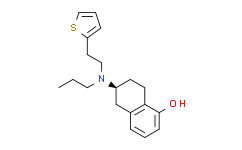| 中文名称: | 罗替戈汀 | ||||
|---|---|---|---|---|---|
| 英文名称: | Rotigotine | ||||
| 别名: | 罗替戈汀 N-0437; N-0923 | ||||
| CAS No: | 99755-59-6 | 分子式: | C19H25NOs | 分子量: | 315.47 |
| CAS No: | 99755-59-6 | ||||
| 分子式: | C19H25NOs | ||||
| 分子量: | 315.47 | ||||
基本信息
|
产品编号: |
R10292 |
||||
|
产品名称: |
Rotigotine |
||||
|
CAS: |
99755-59-6 |
储存条件 |
粉末 |
-20℃ |
四年 |
|
|
|
||||
|
分子式: |
溶于液体 |
-80℃ |
6个月 |
||
|
分子量: |
315.47 |
-20℃ |
1个月 |
||
|
化学名: |
(6S)-6-[propyl(2-thiophen-2-ylethyl)amino]-5,6,7,8-tetrahydronaphthalen-1-ol |
||||
|
Solubility (25°C): |
|||||
|
体外:
|
DMSO |
63mg/mL (199.7mM) |
|||
|
Ethanol |
63mg/mL (199.7mM) |
||||
|
Water |
Insoluble |
||||
|
体内(现配现用): |
|
||||
|
<1mg/ml表示微溶或不溶。 |
|||||
|
普西唐提供的所有化合物浓度为内部测试所得,实际溶液度可能与公布值有所偏差,属于正常的批间细微差异现象。 |
|||||
|
请根据产品在不同溶剂中的溶解度选择合适的溶剂配制储备液;⼀旦配成溶液,请分装保存,避免反复冻融造成的产品失效。 |
|||||
制备储备液
|
浓度
溶液体积 质量 |
1mg |
5mg |
10mg |
|
1mM |
3.1699mL |
15.8494mL |
31.6987mL |
|
5mM |
0.6340mL |
3.1699mL |
6.3397mL |
|
10mM |
0.3170mL |
1.5849mL |
3.1699mL |
|
50mM |
0.0634mL |
0.3170mL |
0.6340mL |
生物活性
|
产品描述 |
一种dopamine receptor 激动剂,是 5-HT1A receptor 的部分激动剂,以及 α2B-adrenergic receptor 的拮抗剂,Ki 值分别为 0.71nM (dopamine D3 receptor),4-15nM (D2,D5,D4 receptors),83nM (dopamine D1 receptor)。 |
|
靶点 |
Dopamine receptor |
|
体外研究 |
Rotigotine (N-0437;N-0923) has a 10-fold selectivity for D3 (pKi 9.2) receptors compared with D2,D4 and D5 (pKi 8.5-8.0) and a 100-fold selectivity compared with D1 receptors (pKi 7.2).In functional studies,Rotigotine behaves as full agonist at all dopamine receptors but notably the potency for stimulation of D1 receptors is similar to that for D2 and D3 receptors (pEC50 respectively:9.0,9.4-8.6,9.7).Rotigotine (10µM) decreases the number of THir neurons by 40% in primary mesencephalic cell culture.Rotigotine (0.01µM) slightly protects dopaminergic neurons against MPP+toxicity,significantly protects dopaminergic neurons against rotenoneinduced cell death,and significantly inhibits ROS production by rotenone. |
|
体内研究 |
In primed rats,Rotigotine (N-0437;N-0923;0.035,0.1 and 0.35mg/kg) induces contralateral turning behavior in a dose dependent manner.In drug naive rats,the turning behavior induced by Rotigotine,either alone or in combination with SCH 39166,is reduced compared to primed rats. |
推荐实验方法(仅供参考)
|
激酶实验: |
|
Binding assays are performed in 96-well polypropylene tubes in a final volume of 2mL for D1 and D4 membranes and 1mL for D2,D3 and D5 membranes containing:50μL radioligand,10μL drug/buffer/non-specific binding,buffer (final concentration 50mM Tris-HCl pH 7.4,MgCl2 2mM) and membranes (5μg protein for D2 and D3 and 25μg protein for D1 and D5).Following 120 min of incubation at 25℃,bound radioligand is determined by rapid vacuum filtration through A/C glass fibre filters presoaked in 0.1% polyethylenimine.The filters are washed four times with 2mL ice-cold ishing buffer (Tris-HCl 50mM,pH 7.4 at 4℃) and retained radioactivity is determined by liquid scintillation counting. |
|
动物实验: |
|
|
Primed rats:Two weeks after the 6-OHDA lesions,rats are primed with apomorphine (0.5mg/kg s.c.).Rats showing less than 150 contralateral rotations during the 1h testing period are excluded from the study.Three days after priming,rats are divided into different experimental groups and treated with different doses of the dopamine receptor agonists (Rotigotine or pramipexole) alone or in combination with dopamine D1 (SCH 39166) or D2 (eticlopride) receptor antagonists as reported:saline+Rotigotine (0.035mg/kg s.c.,n=9;0.1mg/kg s.c.,n=9;0.35mg/kg s.c.,n=8);SCH 39166 (0.1mg/kg s.c.)+Rotigotine (0.035mg/kg s.c.,n=5;0.1mg/kg s.c.,n=7;0.35 mg/kg s.c.,n=5);eticlopride (0.1mg/kg s.c.)+Rotigotine (0.1mg/kg s.c.,n=5;0.35mg/kg s.c.,n=5);Saline+pramipexole (0.035mg/kg s.c.,n=5;0.1mg/kg s.c.,n=12;0.35mg/kg s.c.n=7);SCH 39166 (0.1mg/kg s.c.)+pramipexole (0.035mg/kg s.c.,n=5;0.1mg/kg s.c.,n=6;0.35mg/kg s.c.,n=6); eticlopride (0.1mg/kg s.c.)+pramipexole (0.1mg/kg s.c.,n=7;0.35mg/kg s.c.,n=5). |
|
本计算器可帮助您计算出特定溶液中溶质的质量、溶液浓度和体积之间的关系,公式为:
质量 (g) = 浓度 (mol/L) x 体积 (L) x 分子量 (g/mol)
摩尔浓度计算公式
用本工具协助配置特定浓度的溶液,使用的计算公式为:
开始浓度 x 开始体积 = 最终浓度 x 最终体积
稀释公式
稀释公式一般简略地表示为:C1V1 = C2V2 ( 输入 输出 )








